
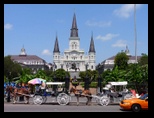
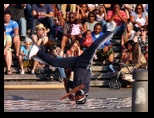
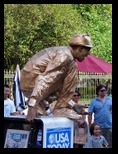
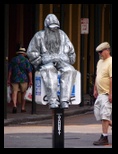
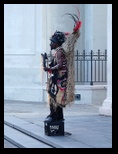
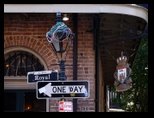
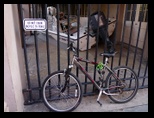
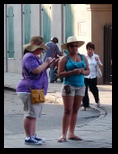


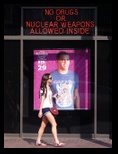
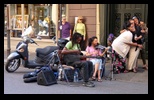
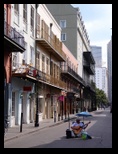
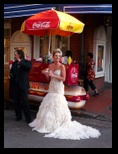

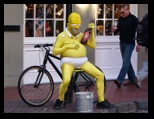
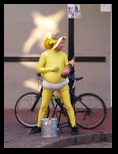
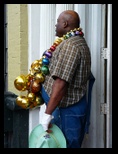
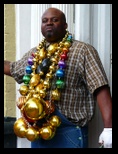
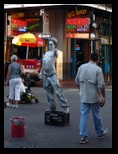
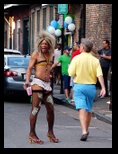

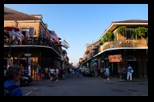

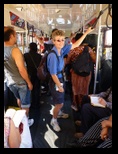
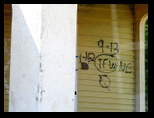


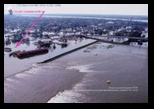


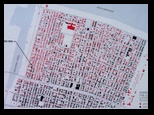
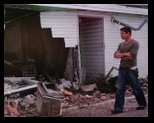
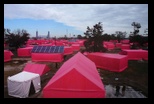
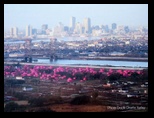
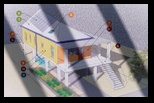

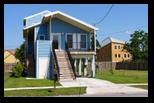



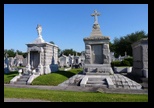

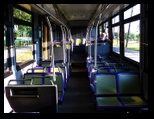
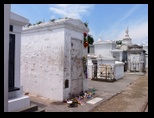


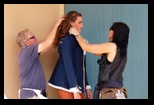
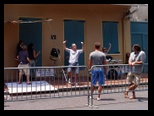
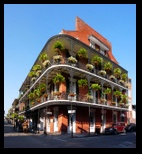
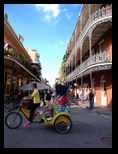
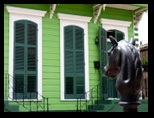

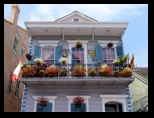
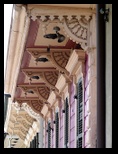
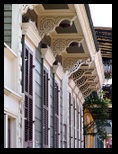
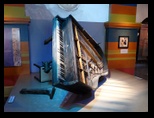
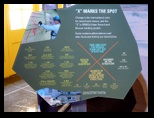
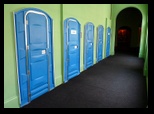
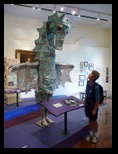
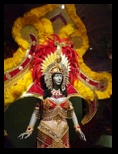
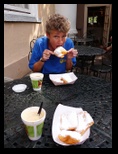
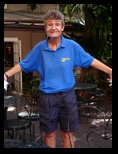
Click on a photo to enlarge it.
In New Orleans we found a really good parking spot at Algiers Point Ferry where we could park over night. $5 per day on weekdays and $10 per day at weekends. We arrived just before 4pm on a Sunday and took the free ferry across the Mississippi River, right into the city centre (French Quarter).
We spent over 3 hours wandering around the streets full of tourists and watching various street performers including a group of break dancers. There was even a wedding couple who had their wedding reception at a hot dog stand! It was such a difference from the last time we were here (Christmas 2004) when it was bitterly cold and the streets were empty.
Bourbon Street.
We spoke to a local woman who told us that the French Quarter and the main tourist areas didn't get damaged by Hurricane Katrina in August 2005. She also said that whilst the levees had been re-built, they were still not up to code and that many people gave up and left because the insurance companies wouldn't pay for the repairs.
The next four paragraphs are a summary from Wikipedia.
Hurricane Katrina was one of the five deadliest hurricanes in the history of the US and was the costliest natural disaster. It's wind speeds reached 175 mph and the pressure measurement made it the fourth most intense hurricane on record at the time but was beaten by two others later in the season. One of those was Hurricane Rita which hit the Louisiana coast only 25 days after Katrina.
At least 1,836 people died as a result of Katrina and total property damage was estimated at $84 billion, nearly triple the damage brought by Hurricane Andrew in 1992. The Levee system catastrophically failed. There were 53 different levee breaches in greater New Orleans, submerging eighty percent of the city and the flood gates were left open. Almost 900,000 people in Louisiana lost power as a result of Hurricane Katrina.
The US Army Corps was blamed for the Levee failure by a judge in 2008 but had sovereign immunity from financial liability. There was also an investigation of the responses from federal, state and local governments, resulting in the resignation of Federal Emergency Management Agency (FEMA) director Michael Brown and the New Orleans Police Department Superintendent Eddie Compass.
An ABC News poll conducted on September 2, 2005, showed more blame was being directed at state and local governments (75%) than at the Federal government (67%), with 44% blaming Bush's leadership directly. Five former police officers have pleaded guilty to charges connected to the Danzinger Bridge shootings in the aftermath of the hurricane. Six other former or current officers appeared in court in June 2011. Two unarmed civilians were killed and four others seriously wounded when police opened fire on people attempting to cross the bridge.
The next day, we went in search of the hardest hit area - the Lower Ninth Ward. We took a street car and then a bus to get there and could already see evidence along the way. This surprised us because it has been 7 years since the hurricane and the area is still more like a wasteland than a housing estate.
When Brad Pitt visited this area two years after Hurricane Katrina, he was shocked by the lack of rebuilding progress. He set up a foundation called "Make it Right" to provide "Green" houses which are more efficient in terms of power and water usage, and are built using recycled materials (www.makeitright.org). They look very different as they are built high on stilts and have metal roofs with solar panels mounted on them.
There were information panels showing that virtually every house was lost. Now, all you can see are the slab walkways leading to a grass area where each house once was. Damaged houses are still standing and have marking written on their doors from the various emergency services and search and rescue teams who came to check for people, dead or alive and then condemn houses that were unsafe.
We could see where the levee walls had been breached and repaired but, all in all, it was quite shocking and gave us an idea of how bad it really was. Our memories of the event and the ensuing news reports were sketchy at best and we needed more information. Fortunately there is an excellent exhibition on Katrina and its effects at the Louisiana State Museum that we went to the next day.
Our three hour visit gave us more insight than we bargained for. The true and tragic consequences are devastatingly shocking. There were lots of videos and maps etc. and a large number of personal reports from people involved. It was heart wrenching.
The Superdome was used to house about 26,000 people but the conditions were atrocious. The toilets were overflowing and, with an outside temperature of over 30 degrees C, the stench was unbelievable. Some people stayed there for 6 days even though the roof was torn off the building by the high winds. Worse, the authorities didn't even realise that the Convention Centre was also being used to house 25,000 people who also needed help and rescue.
According to the reports, one hospital with over 600 people in it was abandoned by rescuers with no water and no electricity. Nurses were hand pumping people on respirators. There was a great deal of confusion with people being told to go to a bridge to be rescued, only to find no buses at all and the bridge was being guarded by police and army who opened fire on the crowd to disperse them. (See summary from Wikipedia above.)
We know from news reports in Germany that there were a huge number of offers of International help which were all refused or rejected. According to Wikipedia a number of offers were accepted eventually. It didn't help that Hurricane Rita hit Louisiana's coast only 25 days later, re-flooding parts of New Orleans and destroying Holly Beach, Cameron and other parts of the coast despite it only being a category 3 hurricane.
Afterwards we went to the Café Beignet for free coffee with beignets for $3. We got icing sugar all over us but we were still in a state of shock from all the reports we'd read and heard.
We also took time to visit some of the many cemeteries with large crypts built above ground. We packed quite a lot in for the short time we were there!